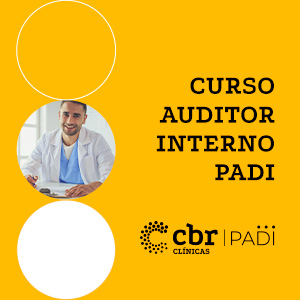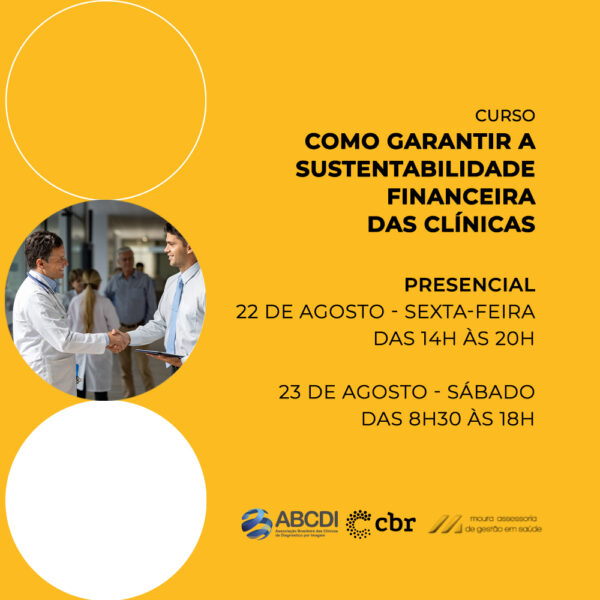R$2.400,00
GENERAL INFORMATION
R$ 2,200.00 – Value for CBR/ABCDI Member in Good Standing
*Non-cumulative discount
R$ 2,400.00 – Amount for Non-CBR/ABCDI Members
Special condition for multiple registrations.
Ask us how!
Format: In person - CBR Headquarters - São Paulo
Date: August 22 – Friday – from 2pm to 8pm
Date: August 23 – Saturday – from 8:30 am to 6 pm
9 Available vacancies
Categories: ABCDI, CBR Clinics, Clinical Courses, Clinic Management
Tags: ABCDI, CBR Clinics, Management
Description

OBJECTIVE
The greatest risk of financial losses for a clinic is in receivables, because health insurance companies have historically been aware of the lack of control that clinics in general have to monitor the receipt of exams on a test-by-test basis. The ANS once published that the Glosses in Supplementary Health are around 6.29%!
For years, the administrative and financial area of clinics has focused mainly on cost reduction, but this model has a rapid exhaustion cycle. Today, cost containment measures have offered a limited impact on clinic profitability.
We will work with indicators that make it possible to understand the profitability of each procedure and each operator, thus being able to structure a business model identifying which prices are possible to charge for each procedure without bringing risk to financial sustainability.
Predictability and planning are very important in the financial area. In this module, we will work in a simple way on how to prepare and monitor revenue budgets, cost and expense budgets, cash flow and EBITDA.
In this module, we will teach you in a practical way how to implement an excellent process by controlling 100% of the values served to guarantee revenue and outline continuous improvement plans to reduce future glosses.
PROGRAM CONTENT
Financial Management Challenges;
Main Functions of Financial Management;
Different Views – Accounting, Economic and Financial;
Caution to invest sparingly;
Main points that we should analyze before investing;
Main short-term and long-term activities;
Main flaws in the Financial Management of Clinics;
Main points – Budget planning;
ANS gloss panel;
History of adoption of TISS Standard changes receivables;
Thoughts for reflection in the Health segment;
Great financial risk of loss for clinics;
Unique characteristics of the healthcare segment;
Excess of commercial information without any pattern in the segment;
COPISS (Committee for Information Standardization;
What are Webservices? (Communication);
Eligibility Types (Security and Privacy);
CBR opinion on the mandatory nature of the TISS standard.
Automated receivables process with traceability;
Receivables panel.
Revenue budget in the Health segment;
Methodology for preparing the revenue budget;
Projection based on five main factors;
Revenue budget monitoring;
The role of budgets in business management;
Main points for preparing budgets;
Some success factors in Implementation;
Preparing cost and expense budgets;
Monitoring cost and expense budgets.
Importance of cash flow in clinics;
Relationship with financial institutions;
Cash flow assumptions;
Cash flow analysis;
Preparation of cash flow and points of attention;
Monitoring the cash flow statement;
What to do with the clinic's profits?;
Frequency of dividend distribution;
Developing the clinic's dividend policy;
Are We Competitive Comparing to Market Benchmarking?
EBITDA Objective;
Positive, Negative and Attention Points of EBITDA;
Cash Basis versus Accrual Basis;
Concept of Accounting and Accelerated Depreciation.
Calculation of EBITDA by production cost center;
How can we calculate EBITDA by service;
Calculation method by production cost center;
The need for apportionment may vary depending on the cost structure;
Method of allocating indirect costs and expenses;
Tool to assist with partial distributions;
Accounts with specific apportionment needs;
Applying the cost and expense values determined by modality and paying source.
TEACHERS

Carlos Moura
He is a Business Administrator with an MBA in IT from USP and an International Human Talent Development Course from the University of Central Florida. With extensive knowledge of the Brazilian diagnostic medicine market, he is an Economic Advisor to the Brazilian College of Radiology and Diagnostic Imaging (CBR), which he represents as a member of the Supplementary Health Information Standardization Committee (COPISS) and the Sector Quality Assessment Technical Committee (COTAQ). He is a partner in Moura Assessoria, a management consultancy in the field of diagnostic medicine. Over the last fifteen years, he has held executive positions in the administrative, commercial and financial areas in the diagnostic medicine segment, among others.

Rodolfo Siqueira
Graduated in Business Administration with emphasis in Information Technology, he has over 12 years of experience in the Brazilian supplementary health market. He held leadership positions in the areas of Market Intelligence, Controllership, Receivables, Commercial and Imaging Diagnostic Management at the fourth largest Diagnostic Medicine company in the world (DASA). He is currently the Manager of Management Consulting for Imaging Diagnostic Clinics, with automation projects, revenue increase and cost reduction, ensuring great results for clients and management training in the health segment.
*For discount information and other payment methods, please contact abcdi@cbr.org.br.
Related courses
-
 Free course
Free coursePadi Webinar - Patient safety center in imaging clinics
-
 Free course
Free courseInternal Auditor Course + Understanding the Padi Standard
At the Student's RhythmR$2.470,00 -
 Free course
Free coursePadi Webinar: Safe patient journey in Mammography
-
 Free course
Free coursePadi Webinar: Safe Use of Contrast: How to Reduce Risks and Improve the Patient Experience



